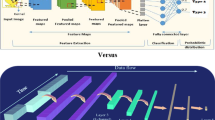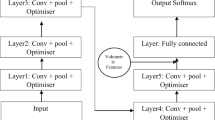Abstract
Alzheimer’s disease (AD) is a progressive brain disease. The goal of this study is to provide a new computer-vision based technique to detect it in an efficient way. The brain-imaging data of 98 AD patients and 98 healthy controls was collected using data augmentation method. Then, convolutional neural network (CNN) was used, CNN is the most successful tool in deep learning. An 8-layer CNN was created with optimal structure obtained by experiences. Three activation functions (AFs): sigmoid, rectified linear unit (ReLU), and leaky ReLU. The three pooling-functions were also tested: average pooling, max pooling, and stochastic pooling. The numerical experiments demonstrated that leaky ReLU and max pooling gave the greatest result in terms of performance. It achieved a sensitivity of 97.96%, a specificity of 97.35%, and an accuracy of 97.65%, respectively. In addition, the proposed approach was compared with eight state-of-the-art approaches. The method increased the classification accuracy by approximately 5% compared to state-of-the-art methods.












Similar content being viewed by others
References
Lange, C. et al., Prediction of Alzheimer's Dementia in Patients with Amnestic Mild Cognitive Impairment in Clinical Routine: Incremental Value of Biomarkers of Neurodegeneration and Brain Amyloidosis Added Stepwise to Cognitive Status. J. Alzheimers Dis. 61(1):373–388, 2018.
Silveira, M. B. et al., F-18-Fluorocholine Uptake and Positron Emission Tomography Imaging in Rat Peritoneal Endometriosis. Reprod. Sci. 25(1):19–25, 2018.
Liu, G., Phillips, P., and Yuan, T.-F., Detection of Alzheimer's Disease by Three-Dimensional Displacement Field Estimation in Structural Magnetic Resonance Imaging. J. Alzheimers Dis. 50(1):233–248, 2016.
Plant, C. et al., Automated detection of brain atrophy patterns based on MRI for the prediction of Alzheimer's disease. NeuroImage. 50(1):162–174, 2010.
Savio, A., and Grana, M., Deformation based feature selection for Computer Aided Diagnosis of Alzheimer's Disease. Expert Syst. Appl. 40(5):1619–1628, 2013.
Gray, K. R. et al., Random forest-based similarity measures for multi-modal classification of Alzheimer's disease. NeuroImage. 65:167–175, 2013.
Zhang, Y., Detection of Alzheimer's disease by displacement field and machine learning. PeerJ. 3:Article ID. e1251, 2015.
Wang, S.-H., Single slice based detection for Alzheimer’s disease via wavelet entropy and multilayer perceptron trained by biogeography-based optimization. Multimed. Tools Appl., 2016. https://doi.org/10.1007/s11042-016-4222-4.
Sun, J.-D., Multivariate Approach for Alzheimer's disease Detection Using Stationary Wavelet Entropy and Predator-Prey Particle Swarm Optimization. J. Alzheimers Dis., 2017. https://doi.org/10.3233/JAD-170069.
Gorji, H. T., and Haddadnia, J., A novel method for early diagnosis of Alzheimer's disease based on pseudo Zernike moment from structural MRI. Neuroscience. 305:361–371, 2015.
Du, S., Alzheimer's Disease Detection by Pseudo Zernike Moment and Linear Regression Classification. CNS Neurol. Disord. Drug Targets. 16(1):11–15, 2017.
Raza, M. et al., Appearance based pedestrians' head pose and body orientation estimation using deep learning. Neurocomputing. 272:647–659, 2018.
Bach-Andersen, M., Romer-Odgaard, B., and Winther, O., Deep learning for automated drivetrain fault detection. Wind Energy. 21(1):29–41, 2018.
Wei, G., Color Image Enhancement based on HVS and PCNN. SCIENCE CHINA Inf. Sci. 53(10):1963–1976, 2010.
Wu, L. N., Segment-based coding of color images. Sci. China Ser. F-Inf. Sci. 52(6):914–925, 2009.
Wu, L. N., Improved image filter based on SPCNN. Sci. China Ser. F-Inf. Sci. 51(12):2115–2125, 2008.
Ardekani, B. A., Figarsky, K., and Sidtis, J. J., Sexual Dimorphism in the Human Corpus Callosum: An MRI Study Using the OASIS Brain Database. Cereb. Cortex. 23(10):2514–2520, 2013.
Marcus, D. S. et al., Open access series of imaging studies (OASIS): Cross-sectional MRI data in young, middle aged, nondemented, and demented older adults. J. Cogn. Neurosci. 19(9):1498–1507, 2007.
Marcus, D. S. et al., Open access series of imaging studies: longitudinal MRI data in nondemented and demented older adults. J. Cogn. Neurosci. 22(12):2677–2684, 2010.
Grassi, M. et al., A Clinically-Translatable Machine Learning Algorithm for the Prediction of Alzheimer's Disease Conversion in Individuals with Mild and Premild Cognitive Impairment. J. Alzheimers Dis. 61(4):1555–1572, 2018.
Sheinerman, K. S. et al., Circulating brain-enriched microRNAs as novel biomarkers for detection and differentiation of neurodegenerative diseases. Alzheimers Res. Ther. 9:13: Article ID. 89, 2017.
Frolich, L. et al., Incremental value of biomarker combinations to predict progression of mild cognitive impairment to Alzheimer's dementia. Alzheimers Res. Ther. 9:15: Article ID. 84, 2017.
Dhal, K. G., Quraishi, M. I., and Das, S., An Improved Cuckoo Search based Optimal Ranged Brightness Preserved Histogram Equalization and Contrast Stretching Method. Int. J. Swarm Intell. Res. 8(1):1–29, 2017.
Lu, H. M., Facial Emotion Recognition Based on Biorthogonal Wavelet Entropy, Fuzzy Support Vector Machine, and Stratified Cross Validation. IEEE Access. 4:8375–8385, 2016.
Gorriz, J. M., and Ramírez, J., Wavelet entropy and directed acyclic graph support vector machine for detection of patients with unilateral hearing loss in MRI scanning. Front. Comput. Neurosci. 10:Article ID. 160, 2016.
Wu, L., Weights optimization of neural network via improved BCO approach. Prog. Electromagn. Res. 83:185–198, 2008.
Jun, Y., and Wei, G., Find multi-objective paths in stochastic networks via chaotic immune PSO. Expert Syst. Appl. 37(3):1911–1919, 2010.
Ozer, I., Ozer, Z., and Findik, O., Noise robust sound event classification with convolutional neural network. Neurocomputing. 272:505–512, 2018.
Trakoolwilaiwan, T. et al., Convolutional neural network for high-accuracy functional near-infrared spectroscopy in a brain-computer interface: three-class classification of rest, right-, and left-hand motor execution. Neurophotonics. 5(1):Article ID. 011008, 2018.
Chen, Y., Voxelwise detection of cerebral microbleed in CADASIL patients by leaky rectified linear unit and early stopping: A class-imbalanced susceptibility-weighted imaging data study. Multimed Tools Appl (2017). https://doi.org/10.1007/s11042-017-4383-9
Hara, K., Saito, D., and Shouno, H., Analysis of Function of Rectified Linear Unit Used in Deep learning. in International Joint Conference on Neural Networks. IEEE: Killarney, IRELAND. 144–151, 2015
Liew, S. S., Khalil-Hani, M., and Bakhteri, R., Bounded activation functions for enhanced training stability of deep neural networks on visual pattern recognition problems. Neurocomputing. 216:718–734, 2016.
Jiang, Y. et al., Cerebral Micro-Bleed Detection Based on the Convolution Neural Network With Rank Based Average Pooling. IEEE Access. 5:16576–16583, 2017.
Hang, S. T., and Aono, M., Bi-linearly weighted fractional max pooling An extension to conventional max pooling for deep convolutional neural network. Multimed. Tools Appl. 76(21):22095–22117, 2017.
Lv, Y.-D., and Sui, Y., Alcoholism detection by data augmentation and convolutional neural network with stochastic pooling. J. Med. Syst. 42(1):Article ID. 2, 2018.
Camps, J. et al., Deep learning for freezing of gait detection in Parkinson's disease patients in their homes using a waist-worn inertial measurement unit. Knowl.-Based Syst. 139:119–131, 2018.
Wawrzynski, P., ASD plus M: Automatic parameter tuning in stochastic optimization and on-line learning. Neural Netw. 96:1–10, 2017.
Hadgu, A.T., Nigam, A., and Diaz-Aviles, E., Large-Scale Learning with AdaGrad on Spark. in International Conference on Big Data. IEEE: Santa Clara, CA. 2828–2830, 2015
Al-Bander, B. et al., Multiscale sequential convolutional neural networks for simultaneous detection of fovea and optic disc. Biomed. Signal Process. Control. 40:91–101, 2018.
Acknowledgements
This paper was supported by Open fund of Key Laboratory of Guangxi High Schools Complex System and Computational Intelligence (2016CSCI01), Natural Science Foundation of China (61602250) and Natural Science Foundation of Jiangsu Province (BK20150983), and National Institutes of Health (P50 AG05681, P01 AG03991, R01 AG021910, P50 MH071616, U24 RR021382, R01 MH56584).
Author information
Authors and Affiliations
Corresponding authors
Ethics declarations
Conflict of interest
We have no conflicts of interest to disclose with regard to the subject matter of this paper.
Additional information
This article is part of the Topical Collection on Image & Signal Processing
Rights and permissions
About this article
Cite this article
Wang, SH., Phillips, P., Sui, Y. et al. Classification of Alzheimer’s Disease Based on Eight-Layer Convolutional Neural Network with Leaky Rectified Linear Unit and Max Pooling. J Med Syst 42, 85 (2018). https://doi.org/10.1007/s10916-018-0932-7
Received:
Accepted:
Published:
DOI: https://doi.org/10.1007/s10916-018-0932-7




